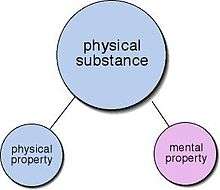Property (philosophy)
In philosophy, mathematics, and logic, a property is a characteristic of an object; a red object is said to have the property of redness. The property may be considered a form of object in its own right, able to possess other properties. A property however differs from individual objects in that it may be instantiated, and often in more than one thing. It differs from the logical/mathematical concept of class by not having any concept of extensionality, and from the philosophical concept of class in that a property is considered to be distinct from the objects which possess it. Understanding how different individual entities (or particulars) can in some sense have some of the same properties is the basis of the problem of universals. The terms attribute and quality have similar meanings.
Essential and accidental properties
In classical Aristotelian terminology, a property (Greek: idion, Latin: proprium) is one of the predicables. It is a non-essential quality of a species (like an accident), but a quality which is nevertheless characteristically present in members of that species. For example, "ability to laugh" may be considered a special characteristic of human beings. However, "laughter" is not an essential quality of the species human, whose Aristotelian definition of "rational animal" does not require laughter. Therefore, in the classical framework, properties are characteristic qualities that are not truly required for the continued existence of an entity but are, nevertheless, possessed by the entity.
Determinate and determinable properties
A property may be classified as either determinate or determinable. A determinable property is one that can get more specific. For example, color is a determinable property because it can be restricted to redness, blueness, etc.[1] A determinate property is one that cannot become more specific. This distinction may be useful in dealing with issues of identity.[2]
Lovely and suspect qualities
Daniel Dennett distinguishes between lovely properties (such as loveliness itself), which, although they require an observer to be recognised, exist latently in perceivable objects; and suspect properties which have no existence at all until attributed by an observer (such as being suspected of a crime)[3]
Property dualism

Property dualism describes a category of positions in the philosophy of mind which hold that, although the world is constituted of just one kind of substance—the physical kind—there exist two distinct kinds of properties: physical properties and mental properties. In other words, it is the view that non-physical, mental properties (such as beliefs, desires and emotions) inhere in some physical substances (namely brains).
Properties and predicates
The ontological fact that something has a property is typically represented in language by applying a predicate to a subject. However, taking any grammatical predicate whatsoever to be a property, or to have a corresponding property, leads to certain difficulties, such as Russell's paradox and the Grelling–Nelson paradox. Moreover, a real property can imply a host of true predicates: for instance, if X has the property of weighing more than 2 kilos, then the predicates "..weighs more than 1.9 kilos", "..weighs more than 1.8 kilos", etc., are all true of it. Other predicates, such as "is an individual", or "has some properties" are uninformative or vacuous. There is some resistance to regarding such so-called "Cambridge properties" as legitimate.[4]
Intrinsic and extrinsic properties
An intrinsic property is a property that an object or a thing has of itself, independently of other things, including its context. An extrinsic (or relational) property is a property that depends on a thing's relationship with other things. The latter is sometimes also called an attribute, since the value of that property is given to the object via its relation with another object. (See the etymology of the word on Wiktionary.) For example, mass is a physical intrinsic property of any physical object, whereas weight is an extrinsic property that varies depending on the strength of the gravitational field in which the respective object is placed. other examples are the name of a person (an attribute given by the person's parents) and the weight or mass of the person.
Relations
A relation is often considered to be a more general case of a property. Relations are true of several particulars, or shared amongst them. Thus the relation ".. is taller than .." holds "between" two individuals, who would occupy the two ellipses ('..'). Relations can be expressed by N-place predicates, where N is greater than 1.
It is widely accepted that there are at least some apparent relational properties which are merely derived from non-relational (or 1-place) properties. For instance "A is heavier than B" is a relational predicate, but it is derived from the two non relational properties: the mass of A and the mass of B. Such relations are called external relations, as opposed to the more genuine internal relations.[5] Some philosophers believe that all relations are external, leading to a scepticism about relations in general, on the basis that external relations have no fundamental existence.
See also
References
- ↑ Stanford Encyclopaedia of Philosophy Determinate and Determinable Properties
- ↑ Georges Dicker (1998). Hume's Epistemology & Metaphysics. Routledge. p. 31.
|access-date=requires|url=(help) - ↑ "Lovely and Suspect Qualities". Retrieved 3 August 2016.
- ↑ Nelson, Michael (1 January 2012). Zalta, Edward N., ed. The Stanford Encyclopedia of Philosophy. Retrieved 3 August 2016 – via Stanford Encyclopedia of Philosophy.
- ↑ George Moore, External and Internal Relations
External links
- Zalta, Edward N. (ed.). "Properties". Stanford Encyclopedia of Philosophy.
- MacBride, Fraser. "Relations". In Zalta, Edward N. Stanford Encyclopedia of Philosophy.
This article incorporates material from property on PlanetMath, which is licensed under the Creative Commons Attribution/Share-Alike License.